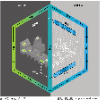Tactile Internet (TI), with the capability of providing multisensory haptic human-machine interactions, is envisioned as a key enabling technology for an emerging application, called human digital twin (HDT). HDT is expected to revolutionize the human lifestyle and prompts the development of Metaverse. However, the realization of HDT poses stringent demands on pervasive connectivity, real-time feedback, high-fidelity modeling and ultra-high reliability (between physical and virtual spaces), which can hardly be met by TI only. In this article, we thus shed light on the design of edge computing empowered TI (ECoTI) for HDT. Aiming at offering strong interactions and extremely immersive quality of experience, we introduce the system architecture of ECoTI for HDT, and analyze its major design requirements and challenges. Moreover, we present core guidelines and detailed steps for system implementations. In addition, we conduct an experimental study based on our recently built testbed, which shows a particular use case of ECoTI for HDT in physical therapy, and the results indicate that the proposed framework, i.e., ECoTI, can significantly improve the effectiveness of the system. Finally, we conclude this article with a brief discussion of open issues and future directions.
翻译:触觉互联网(TI)具有提供多感觉触觉人机交互的能力,被认为是一种关键的启用技术,用于新兴应用程序,称为人类数字孪生(HDT)。预计HDT将革新人类的生活方式并促进元宇宙的发展。但是,实现HDT对普遍连接性、实时反馈、高保真建模和超高可靠性(物理空间和虚拟空间之间)提出了严格的要求,这些要求仅仅通过TI无法实现。因此,本文为HDT设计了边缘计算赋能TI(ECoTI)。旨在提供强大的交互和极度沉浸式用户体验,我们介绍了ECoTI的系统架构,并分析了其主要的设计要求和挑战。此外,我们提出了系统实施的核心指南和详细步骤。另外,我们基于我们最近建立的测试平台进行了实验研究,展示了ECoTI在物理治疗方面的一个特定用例。结果表明,所提出的框架,即ECoTI,可以显著提高系统的有效性。最后,本文简要讨论了未解决的问题和未来方向。



